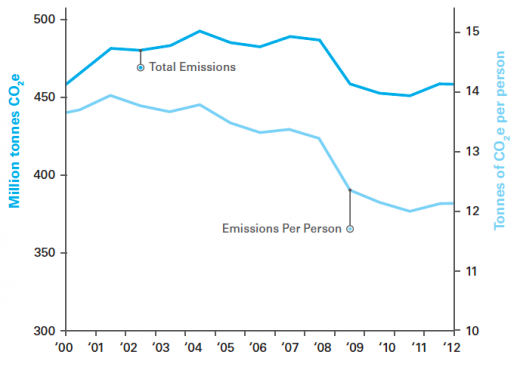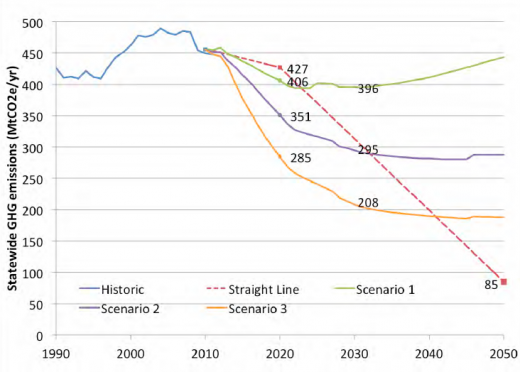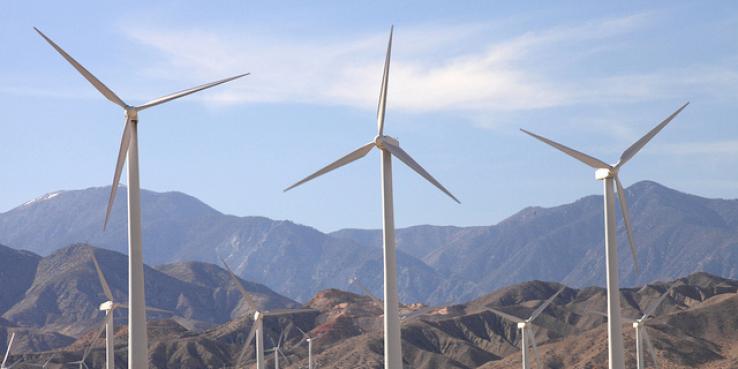California’s landmark environmental bill AB 32 — the Global Warming Solutions Act of 2006 —mandated a reduction of greenhouse gas emissions to 1990 levels by 2020. The policies it set in place have actually worked, and the state is now on track to meet its goal. But what will happen after 2020? With this target date less than six years away, it’s time for the state to set a new objective for continuing its success in reducing emissions.
To understand how AB 32 has worked so well, let’s take a quick look at what it did. In 2008, the California Air Resources Board (ARB), the public agency responsible for meeting the emission targets, wrote a Scoping Plan describing technologically feasible and economically viable tools to reach its goal. It also required emissions to be reported, in order to monitor them. Many policy tools sprung from or were renewed by AB 32, including Cap and Trade, the Low-Carbon Fuel Standard, Advanced Clean Car Standards, the Renewable Portfolio Standard and Sustainable Communities Strategies.
AB 32’s policies have been very effective in slashing overall emissions since 2006 despite a growing economy and population, and they’ve contributed to California’s continued leadership in environmental policy. Both total and per capita greenhouse gas emissions have generally decreased since the enactment of the bill (see Figure 1). While the sharpest drop happened at the height of the recession (2008-2009), greenhouse gas emissions reductions continued even as the economy recovered. (The 2012 spike seen in Figure 1 was caused by reduced hydropower generation due to the drought and to increased use of natural gas to compensate for the closing of a nuclear plant.)
Figure 1. California Total and Per Capita Greenhouse Gas Emissions (2000-2012)

Source: California Air Resources Board, Scoping Plan Update, May 2014.
With the good results of AB 32 policies, and the prospect of transportation fuels coming under Cap and Trade in January 2015, ARB is confident that it will easily meet its 2020 goals. ARB’s optimism is supported by a number of studies, including a 2013 Lawrence Berkeley National Laboratory study that models the state’s greenhouse gas emissions according to projections of population, economic growth and transport use.
These encouraging prospects for California are laid out in ARB’s Scoping Plan Update, published earlier this year. While the agency has been successful in carrying out a number of policies to reduce greenhouse gas emissions in the state, it is looking to consolidate and broaden its framework, notably by better addressing short-lived climate pollutants and greenhouse gas emissions caused by automobile-dependent land uses. ARB is hoping to increase the economic benefits of its environmental policies, as well as the positive interactions between them. The agency’s agenda is busy both at the state level and internationally. In California, ARB is working with the Energy Commission and the Public Utilities Commission to build a more integrated energy plan for the state. Globally, ARB is expanding its international agreements, the most recent one being the linkage of Québec and California’s Cap and Trade programs. Such agreements raise the profile of California as an environmental leader and help increase the credibility of our policy at the federal level.
So what do we do after 2020 to make sure these gains continue? Governor Schwarzenegger formulated an ambitious objective to reduce greenhouse gas emissions 80 percent below 1990 levels by 2050. Although the Lawrence Berkeley National Laboratory study predicts very significant reductions in emissions in the decades following 2020, they will be insufficient to meet this target, even under favorable technological and market conditions. In other words, AB 32, while perfectly fit for 2020, is simply not designed for 2050.
2050 objectives were never included in AB 32, and without the full power of law granted by an assembly bill, they lack sufficient authority to advance aggressive greenhouse gas reductions. Two actions must be taken. The first is codifying the 2050 objectives into law — a sort of AB 32-point-0. The second is a review of existing policies and the scoping of new tools to meet deeper emissions targets.
Figure 2. Three Scenarios for California’s Greenhouse Gas Emissions

These hypothetical scenarios look at three possible futures for statewide greenhouse gas emissions. How likely are we to reduce emissions to 80 percent below 1990 levels by the year 2050? Scenario 1 projects what will happen if we follow existing policies. Scenario 2 projects the effect of existing policies plus the addition of new policies such as zero-net buildings. Scenario three projects both new and existing policies, plus favorable technological and market conditions. The “straight line” links California’s 2020 and 2050 targets.
Source: Estimating Policy-Driven Greenhouse Gas Emissions Trajectories in California: The California Greenhouse Gas Inventory Spreadsheet (GHGIS) Model, Lawrence Berkeley National Laboratory, 2013.
In Sacramento and elsewhere, the conversation has already begun. In 2013, Assembly Member Bill Quirk introduced a bill mandating the creation of a “Road to 2050 Board.” Starting in 2016, this board will produce a series of reports to examine strategies to reach the 2050 goal. These reports will play an advisory role and will help reframe the state’s long-term horizon for greenhouse gas emissions.
ARB is ready to take on post-2020 targets. Although it still aims for 80 percent below 1990 emission levels by 2050, the agency’s latest Scoping Plan Update emphasizes a pragmatic mid-term target for 2030 that would cause no more than 2°C (3.6°F) in temperature rise, the generally agreed upon “guardrail” upper limit of safe global warming. For California, that would translate into emissions about 40 percent below 1990 levels by 2030. To be effective, such a target has to be codified in a new bill and coupled with efficient policies. To this end, ARB has begun a dialogue with the state legislature and will deepen its policy assessment in a new Scoping Plan Update before 2020.
While ARB expects that new targets will be set in the law and appropriate policy will be designed, the details of these agreements are critical and yet to be determined. SPUR has stressed the disastrous consequences of climate change on the Bay Area, and strongly supports the state’s continued and aggressive action on climate change coupled by regional and local action.
